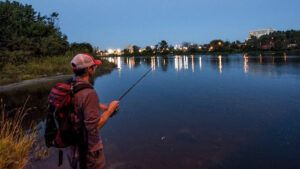Many cities contain lakes and rivers home to largemouth and smallmouth bass. Savvy bank anglers take advantage of these urban opportunities, catching bass around bridges, culverts, canals and other structures amidst the hustle and bustle surrounding city waterways.
There are not hard-and-fast rules, but finesse tactics are perhaps the most consistent at catching fish. If you live in a city and aren’t wetting a line, you need to start because there are a lot of bass out there swimming in a skyline’s shadows.
“City fishing for bass is often a numbers game more than a trophy hunt,” said Jamie Pistilli, former host of the television series Big City Fishing. “Fish tend to be small to average in size, but on a light action rod or a fly fishing set up it’s a lot of fun.”
Pistilli knows his stuff. He’s logged thousands of hours bank fishing since his youth in the cities of Montreal and Ottawa. He and I were frequent bank fishing buddies throughout high-school and continue to fish together.
If you’re new to bank fishing bass around cities, here are the things we believe will help you catch more fish and have a lot of fun.
- How to find bank fishing spots
- Must-fish spots for bass in cities
- City fishing tactics
- Tackle tips
- Location tips
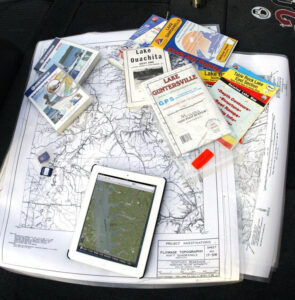
How to find bank fishing spots in cities
When starting out city bank fishing, you need to find good shoreline access points near productive bass habitat. Consider these 4 tips.
1. Internet study
Google Earth provides a picture of city waters and potential fishing areas. It shows bridges, islands, piers, coves, canals, river bends and shallow contours.
2. Mobile depth charts
Electronic depth charts provide another piece of the puzzle. For instance, using the Navionics App I bought for my iPhone I can shortlist points, contour push-outs and shallow to mid flats along the Ottawa River, which acts as the northern boundary of my home city.
3. Paper maps
A recreational map is handy because biking and walking trails frequently trace the shorelines of city waterways. Paths make it easy to access the bank and move from one spot to another. Using a bike to quickly cover ground instead of walking is the equivalent of swapping oars for a trolling motor in a tinny.
4. Find visible queues
Pistilli scouts city shorelines during drawdown periods. Certain structures underwater become visible during low-water. Learning where these are will payoff once water levels rise.
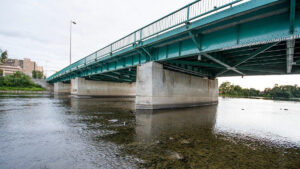
6 must-fish spots for bass in cities
There are many places to catch bass from waters within cities. Here are 6 worth casting.
5. Bridges
“Bass hold around bridges all the time,” Pistilli said. “Bridges always have rocks around them and create current breaks. They also tend to have deeper water compared to a lot of city spots, so they’re good places to start your search.”
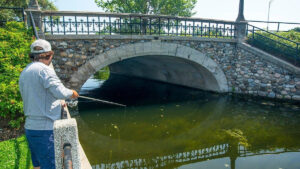
6. Culverts
Culverts can be bass magnets. Low to the water, a culvert creates shade. Their construction involves rocks and riprap, which attract bass.
Culverts are also designed to let water flow, so current’s common. Look for bass along seams and in eddies on the downstream side of the structure.
7. Waterfront walls
Concrete walls contain and direct city waterways. At times, bass relate to these walls for shade. Erosion can also cause indents in the wall, or “urban undercuts.”
Rock, riprap, concrete supports and other debris along the wall cause gaps in grass beds, creating an inside grass line, so to speak. An accurate cast parallel to the wall is as straightforward as it gets to work over this zone.
Break walls are common on cities bordering big water. Bass forage around broken concrete and riprap. Be warned, though, as craggy rocks eat bottom-contact baits without prejudice. Horizontal presentations and slow-sinking finesse rigs are less risky.
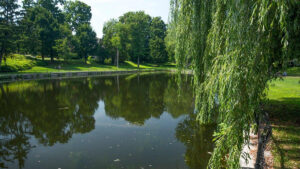
8. Coves and cuts
Artificial bays, coves, canals and inlets are common in cities. When these areas are rich in vegetation and teeming with sunfish, expect to find largemouth bass. You can do a lot worse than peppering these areas with a hollow belly frog.
9. Inflowing water
Water feeding a larger lake or river attracts bass. In cities it could be from storm-water discharge or a tributary stream.
Inflowing water also erodes bottom. This creates outwash holes or cuts in the floor, both of which are worth casting.
A waterfall’s another scenario. Smallmouth bass love the base of falls. Focus efforts on deep pools, boulders, logs and eddies.
10. Overhead cover
Much like urbanites preferring to walk on the shaded side of a street, city bass like the shadows. Docks are always worth fishing and can be found at marinas, boat launches, boat rental operations and along canals.
Largemouth will also feel right at home under the protective canopy of, floating mats and emergent vegetation. Shade from trees is just as good. Lay downs are another good bank fishing find.
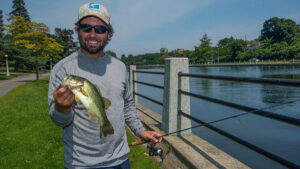
City-bassin’ tactics
While city bass fishing follows many bank fishing fundamentals, here are 6 things to consider on your next urban angling adventure.
11. Walk and stalk
“Like someone living downtown who gets used to all the noise and can sleep through the sirens and horns, city bass are used to pedestrian traffic along walkways, so it’s a little easier to walk a path and sight-fish for them,” Pistilli said.
This said, big fish have street smarts, so be stealthy along the bank. Pistilli looks for bigger bass tucked-in tight to cover.
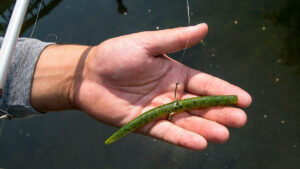
12. Bet on finesse
Urban bass see heavy fishing pressure. Finesse rigs get the job done most days. Small tubes, grubs, finesse worms, wacky rigged stickbaits and the Neko rig are good picks.
The Ned rig is deadly. In addition to bass chomping the Z-Man Finesse TDR and Hula Stickz, I like ElaZtech’s durability, which means I don’t need a lot of baits. I’m a tackle junkie, but aim to keep things light when lugging gear on foot.
13. Mix it up
“I like extremes,” Pistilli said. “I catch a ton of city bass with 1/16-ounce Berkley PowerBait Atomic Teasers. Its got a great action for a small bait and it catches bass of all sizes, not to mention a bunch of other fish. When the Teaser isn’t working, I’ll often go to the other extreme and try throwing the biggest spinnerbait in my box. If this strikes out, I’ll likely be going back to my car to get my fly rod and trying a woolly bugger. The key with city fishing is giving bass something different to look at compared to what other anglers are using. You’ve got to mix it up. ”
14. Trick casts
Skipping a bait, like a tube or stickbait, under a doc, into a culvert or beneath an overhanging tree helps fish water others can’t. A skip cast also has a natural entry in the water. This is important when chasing pressured, urban bass.
A ricochet cast’s also handy. Cast a bait at a piece of structure, feathering line to slow it as it approaches the target. Let the bait bump the object and then drop into the water. Bass are easily duped by this bumper-car technique, but it’s not recommended for lures with fancy paint jobs.
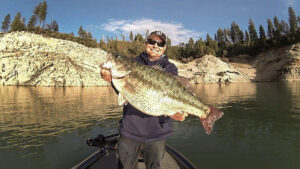
15. Recycle spots
“Most urban spots aren’t a secret,” Pistilli said. “It’s best to fish them more than once in a day. The more times you can contact them, the better your chances of being there when a bass wants to eat.”
16. Bookend magic
Early morning and evening are good times to fish city bass. Fish get active during low light periods. Bigger, timid bass lower their defenses. Topwaters and wake baits shine in these low-light conditions.
Exploring urban waters for bass is a great way to sneak in a lunch hour fish or wet a line in the evening. If you’re fortunate, you’ll land a quality fish, but generally urban fishing is a numbers game. Of course, the surprised looks and curious questions get from onlooking pedestrians only adds to the flavor and fun of city-limit bassin’.
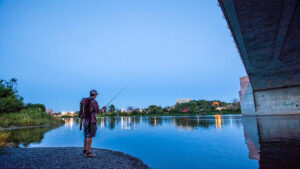
17. Tackle tips
- Two-piece and travel rods breakdown into smaller packages, making travel easier.
- Urban waters often contain a lot of vegetation. Stock-up on lighter jigs, hooks with weed guards, and bullet weights and worm hooks for Texas rigging.
- Use a backpack or lumbar pack for carrying fishing gear. These packs balance weight, which is useful when scrambling over riprap or leaning over to make a trick cast.
18. Location tips
- Not all urban areas are angling friendly. “No fishing” signs can be common on bridges, piers and walkways.
- Avoid a bad encounter and watch for poison ivy in shady, shoreline areas containing grass and underbrush.
WANT TO READ MORE BANK FISHING ARTICLES? CHECK THESE OUT:
- 5 Tips for More Bank Fishing Success
- 5 Must-Have Bank-Fishing Baits
- How to Find Bass Quickly From the Bank
- 4 Ways to Increase Your Bank Fishing Success
- More Pond and Bank Fishing Features here
